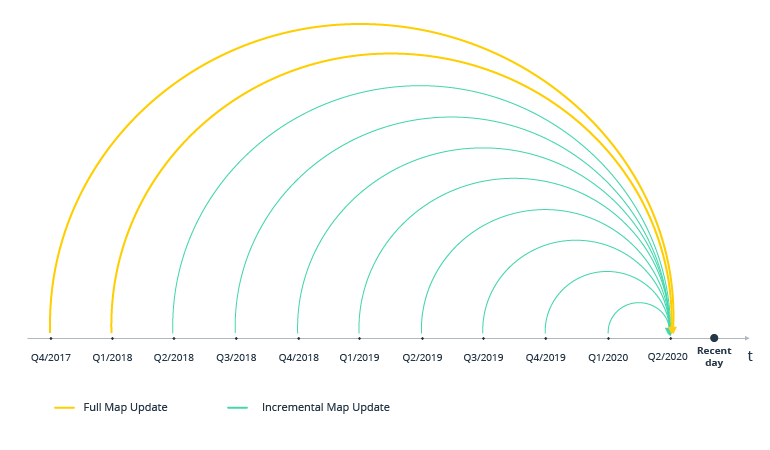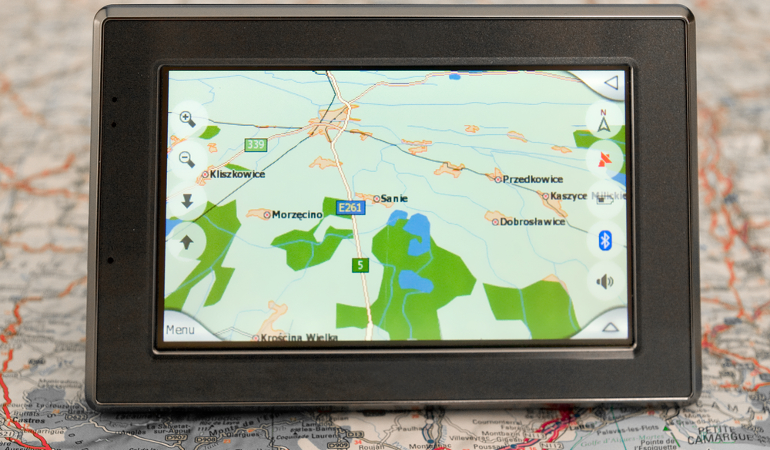Gone are the days of pulling the car over, searching for a map to figure out where you are or where you’re going. Arguing with your fellow passenger about going in the wrong direction is now a distant memory.
Thanks to state-of-the-art infotainment systems, with digital maps installed on your embedded navigation, you can get to your destination in peace. Unless met with an unexpected traffic system or roadworks. Then you may find yourself dangerously driving the wrong way up a one-way street, shouting at your navigation system instead.
Sure, you could leave your car in a dealership overnight and get the map updated once, or twice a year, but the spontaneity of a road trip is lost.
This is where over the air updates come into play. Using a wireless network, you can receive map and navigation updates directly from your car manufacturer in the comfort of your own, well, the car actually. With the touch of a button, the OTA software update is instantly applied. You can even schedule automatic OTA updating once a new map becomes available.
The role of the OTA software update in the future of autonomous driving

For the autonomous driving ecosystem to thrive, OTA updating will play an essential role. Along with V2X connectivity, OTA technology allows the cars ahead to share detailed information immediately for cars behind, to improve traffic flow. The cycle of content updates from infrastructure, vehicles, and traffic systems, must be reduced from months or years to seconds for this future to be realized.
Essential components of OTA software update technology for vehicles will include data on:
- Road repairs
- Weather conditions
- Closed roads
- Alternative routes
- Traffic jams
- Locations of e-vehicle charging stations
- Points of interest
Let’s find out how to implement one of the most essential over the air software updates that are already in use, namely map updates for connected car navigation.
Requirements of OTA software update technology for vehicles

Cloud software development and implementation of OTA technology architecture must be a top priority for OEMs, as a certain framework must be put in place to allow this technology to be applied.
In-car navigation systems need a pre-installed map, and cars must have at minimum 3G wireless capabilities.
The updated server URL should be properly configured, so the navigation system can check the server address to see what new maps are available.
The list of regions to be updated must be configured before the navigation system can trigger OTA updates to connected vehicles.
Each vehicle’s OTA service can then connect to the update server and check if the server contains updates for any given region.
Navigation systems have to understand and distinguish when a map region is out of range to receive an incremental update, and instead provide a full map update.
Two main types of OTA technology in cars available
1. Quarterly Map Updates
The simple way of implementing over the air software updates is to provide a patch four times a year. For each available update region, a new version of the map can be supported. Updating the map in parts saves data traffic and time since the download is much faster.
Quarterly updates include up to eight incremental updates, after that the map will be updated fully. BMW has been implementing OTA navigation updates using their Connected Drive system, which informs drivers of new roads and modified traffic layouts.

2. Full Map Updates
When a quarterly or patch update is too large or almost equal to the whole map update size, then a full map update is required.
Although patches can take more time to be installed, they are much faster to download. The advantages of patches cannot be applied here, as the file size is too big. It’s more efficient to update the full map, which is easier to install and can take the same amount of time to download as a big patch.
Also, the third type of update could be applied. This involves streaming data in real time, utilizing the benefits of V2X connectivity. Continuous updates without the participation of users are essential for autonomous driving. Connected car companies are already working to overcome the challenges faced to bring this idea to life.
OEMs currently competing for connected car solutions

The list of car manufacturers introducing OTA updates to connected vehicles is rapidly gaining pace. Using a variety of technologies, OEMs are providing this service to enable secure over-the-air updates for cars.
- Tesla is at the forefront of this technology and has been sending OTA updates through an embedded AT&T 3G data connection or a Wi-Fi router for their Tesla Model S cars.
- GM’s Chevy Volt is using the OnStar Verizon 3G data connection.
- Mercedes mbrace2 system is utilizing OTA through an embedded Verizon 3G data connection, for it’s C and S Class cars. The updates are pushed into the system and are updated during the next vehicle start.
- Chrysler’s Uconnect system sends OTA updates through an embedded Sprint 3G data connection or Wi-Fi router for its Pacifica and 300 range of cars, applying the same process as Mercedes.
- Audi’s Connect system sends updates through an embedded T-Mobile 3G data connection for its A3, A4, A5, Q2, Q5, and Q7 cars.
- Toyota and Mazda are pairing up to use Entune 3.0 to provide OTA updates using wireless, Bluetooth, or USB smartphone data connections.
BMW, Audi and Tesla have recently announced OTA procedures for updating navigation maps. Hyundai and Ford/Lincoln both have proof of concept systems for OTA map updates. Total map OTA enabled car sales are projected to grow from 397,000 units in 2015 to over 10M units by 2022.
In addition to OEMs working on automotive OTA updates, an increasing amount of Tier 1 vendors and connected car companies are raising the stakes to provide this service.
How to simplify OTA automotive updates

To reduce the effort and accelerate time to complete these complex data transfers, over-the-air broadcast maps are divided into regions. The navigation system identifies and supports favorite regions where users frequently drive, or the driver can choose how many regions to set up.
As the car approaches a new region, the navigation system can ask to install the region’s map at a defined distance before arrival. Alternatively, drivers can manually choose the regions to be updated.
OTA automotive updates can be initiated automatically, or manually if the driver prefers. In the case of automatic updates, navigation searches for a new version within a chosen time frame. Drivers of cars with OTA updates can approve the installation each time, or opt for the system to update always if the new version is available.
Over the air software updates pave the way forward for autonomous driving

By 2022 nearly 160 million vehicles are expected to have the technology for over the air updates embedded in their hardware, according to IHS Automotive. OEMs can introduce a user-friendly interface for manual entry of possible regions or any other required updates. Voice assistance technology further increases the accessibility, allowing the user to choose how regular the updates should be.
For autonomous driving OTA updates, the map and navigation system will provide:
- Terrain level data
- Road sign updates
- Road repairs
- Closed roads
- Traffic congestion
- Road markings
This information is utilized for the process of path planning. Path planning and decision-making for autonomous vehicles in urban environments, enable self-driving cars to find the safest, most convenient, and most economically beneficial routes from point A to point B.
OEM requirements for successful over the air updates

OEMs must provide failure resistance for downloaded data. You might be familiar with downloading a file on your computer, only for the connection to be lost and the file ends up corrupted. With failure resistance, if the connection is disrupted, the navigation system will continue to download the map in the exact same place when the connection is renewed.
Map validation is also necessary before installation. For example, if a car is already in Switzerland and the server proposes an update on the map for Germany, the update will be declined, and the navigation will choose a new update for this particular region.

With one billion electric cars predicted to be on the road by 2050, the ability to provide a smart route plan, which includes the locations of charging stations along the route to the destination point is another requirement.
For the convenience of users, updates should include information on points of interest, hotels, restaurants, ATMs, shops, and parking spots nearby.
The bright future of OTA technology in cars

Worldwide sales of connected cars are expected to reach 72.5 million units by 2023. Global network infrastructure must be created to effectively and efficiently distribute software for cars with OTA updates. OEMs and automotive tech companies are racing to implement this technology, as it is a key component of the autonomous driving future, especially in terms of safe navigation.
Are you ready to make a move to provide OTA updating for your customers? If your answer is yes, then your next move is to implement OTA updates with a partner who has decades of experience developing similar connected car solutions for a wide range of OEMs from Germany, the UK, Japan, and South Korea.
Contact Intellias to create your own OTA updating solutions today.



